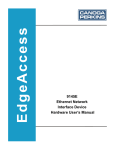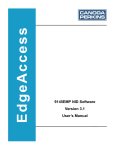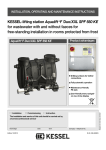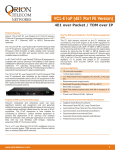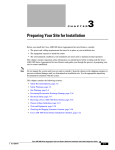Download 9145EMP Network Interface Device Hardware User`s Manual
Transcript
EdgeAccess 9145EMP Network Interface Device Hardware User’s Manual NOTICE Canoga Perkins has prepared this manual for use by customers and Canoga Perkins personnel as a guide for the proper installation, operation and/or maintenance of Canoga Perkins equipment. The drawings, specifications and information contained in this document are the property of Canoga Perkins and any unauthorized use or disclosure of such drawings, specifications and information is prohibited. Canoga Perkins reserves the right to change or update the contents of this manual and to change the specifications of its products at any time without prior notification. Every effort has been made to keep the information in this document current and accurate as of the date of publication or revision. However, no guarantee is given or implied that the document is error free or that it is accurate with regard to any specification. CANOGA PERKINS CORPORATION 20600 Prairie Street Chatsworth, California 91311-6008 Business Phone: (818) 718-6300 (Monday through Friday 7 a.m. - 5 p.m. Pacific Time) FAX: (818) 718-6312 (24 hrs.) Web Site: www.canoga.com E-mail: [email protected] Copyright © 2010 Canoga Perkins Corporation All Rights Reserved EdgeAccess® 9145EMP NID Hardware User’s Manual Model Number 9145EMP Part Number 6913800 Rev A 04/2010 EdgeAccess and Canoga Perkins are registered trademarks of Canoga Perkins Corp. To find Technical Advisories and Product Release Notes, go to the Canoga Perkins web site at http://www.canoga.com. 9145EMP Network Interface Device Hardware User’s Manual CAUTION! This product may contain a laser diode emitter operating at a wavelength of 1300 nm - 1600 nm. Use of optical instruments (for example: collimating optics) with this product may increase eye hazard. Use of controls or adjustments or performing procedures other than those specified herein may result in hazardous radiation exposure. Under normal conditions, the radiation levels emitted by this product are under the Class 1 limits in 21 CFR Chapter 1, Subchapter J. ATTENTION! Ce produit peut contenir un émetteur de diode de laser fonctionnant à une longueur d'onde 1300 de nm - nm 1600. Utilisation des instruments optiques (par exemple: la collimation du système optique) avec ce produit peut augmenter le danger. L'utilisation des commandes ou des ajustements ou les procédures d'exécution autre que ceux indiquées ci-dessus peut avoir comme conséquence l'exposition de la radiation dangereuse. Dans des conditions normales, les niveaux de rayonnement émis par ce produit sont sous les limites de la classe 1 en chapitre 1, Subchapter J de 21 CFR. NOTICE! This device contains static sensitive components. It should be handled only with proper Electrostatic Discharge (ESD) grounding procedures. AVIS! Ce dispositif contient les composants sensibles statiques. Il devrait être manipulé seulement avec la Décharge Electrostatique (DES) appropriée procédures. i 9145EMP Network Interface Device Hardware User’s Manual General Safety Considerations Installation The 9145EMP is suitable for installation in Network telecommunication facilities and locations where the National Electric Code (NEC) applies. Cabling The 9145EMP has been designed and tested and has passed all the pertinent sections of GR1089 and GR-63 for Type 2 and Type 4 equipment. This equipment does not have direct electrical connection to outside plant equipment. The Copper (RJ45) ports of the 9145EMP are not intended for direct connection to “Outside Plant” metallic conductors and shall be isolated (by channel banks or office repeaters) from any connections to network or terminal equipment that lie outside of the same building. The telecommunication interface connections are considered to be, and meet the requirements of, SELV circuits (not TNV). Power WARNING: The 9145EMP with redundant power supplies must have both power supply cords disconnected before servicing. Wiring methods used for the connection of the equipment to the AC or DC MAINS SUPPLY shall be in accordance with the National Electrical Code, ANSI/NFPA 70, and the Canadian Electrical Code, Part I, CSA C22.1. The 9145EMP AC and DC units do not incorporate a disconnect device. The plug on the power supply cord is intended to serve as the disconnect device. It is also recommended that the AC socket-outlet shall be installed near the equipment and shall be easily accessible. The 9145EMP DC has a nominal operating DC voltage of -48 VDC and passes the minimal steady state DC operating voltage of -40 VDC in accordance with GR-1089 Issue 4 which references American National Standards Institute (ANSI) T1.315, Table 1. Additionally, Canoga Perkins design allows for a minimal steady state of -36VDC. The 9145EMP DC model is configured for a DC-I, Isolated DC return. Fuses The 9145EMP is equipped with internal fuses. The AC model is fused at 2A and the 48VDC model at 3.0A. Although not required, an external fuse may be used to isolate the unit in a shared fuse distribution panel. In that case, the unit should be fused with a 3A slow blow fuse or a 5A fast acting fuse for 48VDC input voltages. ii 9145EMP Network Interface Device Hardware User’s Manual Surge Protection The AC powered 9145EMP does not contain an internal Surge Protective Device. An external Surge Protective Device (SPD) should be used at the AC input of the network equipment according to facilities procedures and as defined by the National Electric Code (NEC). Grounding The 9145EMP AC & DC models are suitable for installation as part of the Common Bonding Network (CBN). The 9145EMP AC and DC are provided with a safety ground connection which is capable of conducting any fault current likely to be imposed such as fault current from sources within the chassis. For the DC model use an approved 18ga insulated wire connected to the terminal block’s middle conductor. The plus and minus 48VDC conductors should be a minimum of 20ga. The AC will be grounded via the ground conductor of the power cord and must be connected to an earthed mains socket-outlet. An electrical conducting path should exist between the 9145EMP chassis and the metal surface of the enclosure or rack in which it is mounted or to a grounding conductor. Electrical continuity should be provided by using thread-forming type mounting screws that remove any paint or nonconductive coatings and establish a metal-to-metal contact. Any paint or other nonconductive coatings should be removed on the surfaces between the mounting hardware and the enclosure or rack. The surfaces should be cleaned and an antioxidant applied before installation. Lightning Protection The intra-building ports of the 9145EMP are suitable for connection to intrabuilding or unexposed wiring or cabling only. The intra-building port(s) of the equipment or subassembly MUST NOT be metallically connected to interfaces that connect to the OSP or its wiring. These interfaces are designed for use as intra-building interfaces only (Type 2 or Type 4 ports as described in GR1089-CORE, Issue 4) and require isolation from the exposed OSP cabling. The addition of Primary Protectors is not sufficient protection in order to connect these interfaces metallically to OSP wiring. To protect the port against intra-building lightning surges, the RJ45 ports of 9145EMP are suitable for connection to shielded intra-building cabling grounded at both ends. ESD The 9145EMP has been tested and passes the ESD requirements of Test level 4 for air and contact discharges. However to protect the exposed components from electrostatic damage when removing or replacing the small form-factor pluggable (SFP) optical modules requires the proper use of static mitigation procedures such as properly wearing a wrist strap. iii 9145EMP Network Interface Device Hardware User’s Manual Operation Temperature The 9145EMP is designed and Nationally Recognized Test Laboratory (NRTL) tested and verified to operate between 0°C to 50°C, and type teste d for short term emergency ambient temperature of -5°C to 55°C. Fans The 9145EMP models equipped with fans are constructed with a mid-front to mid-rear (EC class F2-R2) airflow scheme, i.e., it draws air from the front and exhausts to the rear. The 9145EMP models equipped with redundant fans are designed to function normally over the entire long-term operating temperature range; in the unlikely event of a single fan failure, the 9145EMP will continue to perform normally over the long-term operation temperature range until a replacement can be installed. Fan replacement cannot be performed in the field. Call Canoga Perkins for an RMA number to arrange a repair. Emissions and Immunity This device complies with part 15 of the FCC rules. Operation is subject to the following two conditions: 1. This device may not cause harmful interference 2. This device must accept any interference received, including interference that may cause undesired operation. The authority to operate this equipment is conditioned by the requirements that no modifications will be made to the equipment unless the changes or modifications are expressly approved by the Canoga Perkins Corporation. To Users of Digital Apparatus in Canada: This Class A digital apparatus meets all requirements of the Canadian interference-causing equipment regulations. Aux utilisateurs des appareils numérique au Canada: Cet appareil numérique de la classe A respecte toutes les exigences du règlement sur le matérial brouilleur du Canada. Special Accessories The 9145EMP does not require any special accessories to achieve compliance for emission and immunity criteria. Double Pole/Neutral Fusing On the 9145EMP a fuse may be in place in the neutral path on the AC power supply. After operation of the fuse, parts of the equipment that remain energized might represent a hazard during servicing. iv 9145EMP Network Interface Device Hardware User’s Manual Waste Electrical and Electronic Equipment (WEEE) Product Disposal Information Do not dispose of this product in unsorted municipal waste. This product is recyclable, and should be recycled according to your local standards. For more information, contact Canoga Perkins technical support. v 9145EMP Network Interface Device Hardware User’s Manual vi 9145EMP Network Interface Device Hardware User’s Manual Contents 1 Introduction .......................................................................................... 1 1.1 Product Description ........................................................................................... 1 1.2 9145EMP Specifications ................................................................................... 2 1.2.1 Physical Characteristics ............................................................................. 2 1.2.2 Environmental Characteristics ................................................................... 2 1.2.3 Power Requirements ................................................................................. 2 1.2.4 Regulatory Compliance .............................................................................. 2 1.3 Mounting Options .............................................................................................. 2 1.3.1 Rack Mounting ........................................................................................... 3 1.3.2 Wall Mounting ............................................................................................ 3 2 Functional Description ........................................................................ 5 2.1 Base Unit ........................................................................................................... 5 2.2 Hardware Configuration .................................................................................... 7 2.2.1 Front Panel ................................................................................................ 7 2.2.2 Rear Panel ................................................................................................. 8 2.2.3 Service Data Ports ..................................................................................... 8 2.3 Management Ports ............................................................................................ 9 2.3.1 EIA-232 Console Port ................................................................................ 9 2.3.2 Ethernet Management Port ........................................................................ 9 2.4 Port Default Settings ....................................................................................... 10 vii 9145EMP Network Interface Device Hardare User’s Manual 2.5 Power Connectors ........................................................................................... 10 2.5.1 Power Requirements ............................................................................... 10 2.5.2 Single AC Power Base Unit ..................................................................... 10 2.5.3 Redundant AC Power Base Unit .............................................................. 11 2.5.4 Single DC Power Base Unit ..................................................................... 11 2.5.5 Redundant DC Power Base Unit ............................................................. 11 2.5.6 AC/DC Power Base Unit .......................................................................... 12 2.6 LED Indicators ................................................................................................. 12 2.6.1 Management Section LEDs ..................................................................... 13 2.6.2 Data Interface Section LEDs.................................................................... 14 3 Installation .......................................................................................... 17 3.1 9145EMP Installation Procedures ................................................................... 17 3.2 Unpacking ....................................................................................................... 17 3.3 Mounting Options ............................................................................................ 18 3.3.1 Rack Mounting ......................................................................................... 18 3.3.2 Wall Mounting .......................................................................................... 22 3.3.3 Horizontal Flat Surface Mounting ............................................................. 23 3.4 Installing the SFP Modules .............................................................................. 24 3.5 Connecting the Electrical Power ..................................................................... 24 3.5.1 AC Power ................................................................................................. 24 3.5.2 DC Power ................................................................................................. 25 3.5.3 Grounding ................................................................................................ 26 3.5.4 Connecting the Fiber Optic and UTP Ethernet Cables ............................ 27 viii 9145EMP Network Interface Device Hardware User’s Manual 4 Operation ............................................................................................ 29 4.1 Power-Up and Front Panel Functions ............................................................. 29 4.1.1 Power and Status LEDS .......................................................................... 29 4.2 Interface Management .................................................................................... 30 4.2.1 Setting Up the VT-100 Terminal .............................................................. 30 5 Troubleshooting ................................................................................. 31 5.1 Optical Power Loss ......................................................................................... 31 5.2 Fault Conditions .............................................................................................. 31 5.3 Running Diagnostics ....................................................................................... 31 5.3.1 PING Testing ........................................................................................... 31 5.4 Loopback Diagnostics ..................................................................................... 32 6 Maintenance ........................................................................................ 33 6.1 General Maintenance ...................................................................................... 33 6.2 Check Optical Power Levels ........................................................................... 33 6.2.1 Measuring Transmitter Output Power ...................................................... 33 6.2.2 Measuring Receiver Input Power............................................................. 34 6.2.3 Calculating Fiber Link Attenuation ........................................................... 35 ix 9145EMP Network Interface Device Hardare User’s Manual x Introduction 9145EMP Network Interface Device Hardware User’s Manual Product Description Chapter 1 Introduction 1.1 Product Description The 9145EMP (Figure 1-1) is the Canoga Perkins second generation Network Interface Device (NID) that can be used by a Service Provider (SP) to provide layer 1 and layer 2 termination of Ethernet services. The 9145EMP encompasses features and functions needed by SPs to deliver Metro Ethernet Forum (MEF) compliant Ethernet services with end-to-end Quality of Service (QoS) guarantees and Operation, Administration, Maintenance and Provisioning (OAM&P) capabilities. Figure 1-1 9145EMP Ethernet Network Interface Device 1 9145EMP Network Interface Device Hardware User’s Manual Introduction 9145EMP Specifications 1.2 9145EMP Specifications 1.2.1 Physical Characteristics • Dimensions: 1.75" H x 8.25" W x 11.5" D (44.5 x 209.5 x 292 mm) • Weight: 5.5 lb (2.49 Kg), depending on model 1.2.2 Environmental Characteristics • Operating Temperature: 0° to 50° C • Operating Humidity: 0 to 90% Relative Humidity (non-condensing) 1.2.3 Power Requirements • 100 VAC to 240 VAC (auto-ranging), 50/60 Hz, 0.5 Amps • 48VDC (36 to 72VDC), 1 Amp 1.2.4 Regulatory Compliance • EN60825-1 (laser safety) • CE Mark • EMC Directive (EN55022 Class A, EN 55024, EN 61000-3-2/-3-3) • ETL, cETL & LVD (U.S. UL60950, CAN/CSA C22.2 No. 60950, EN/IEC 60950) • FCC Part 15B Class A (U.S.), ICES-003 (CAN), VCCI Class A (Japan), C-Tick (AS/NZS 3548 - Australia) • NEBS Level 3 1.3 Mounting Options • 19-Inch or 23-Inch rack mount (single unit or two units side by side in a 1U) • Wall Mount (face down or to either side) • Table Top See Chapter 3, Installation, for installation procedures. 2 Introduction 9145EMP Network Interface Device Hardware User’s Manual Mounting Options 1.3.1 Rack Mounting The customer is required to order the brackets required (Figure 1-2) for their particular rack installation. Figure 1-2 9145EMP Mounting Brackets 1.3.2 Wall Mounting Canoga Perkins includes a mounting template in the shipping container (Figure 1-3) to assist the customer in mounting the 9145EMP on a wall. Figure 1-3 Wall Mounting Template 3 9145EMP Network Interface Device Hardware User’s Manual Introduction Mounting Options 4 Functional Description 9145EMP Network Interface Device Hardware User’s Manual Base Unit Chapter 2 Functional Description 2.1 Base Unit The 9145EMP is designed with front-panel data and management ports and rear-panel power and ground connectors. This design allows for a multitude of power options. The 9145EMP model numbers and configurations are described in Table 2-1. SFP model numbers are described in Table 2-2. All models accommodate feature enhancements through firmware upgrades. Table 2-1 9145EMP Model Numbers and Configuration Model Number Extended Description 9145EMP-761-0-0 9145E Multiport, Four UTP/SFP User Ports, Two SFP Network Ports, Local Ethernet UTP Management Port, Single AC Power Supply, Integral Fans 9145EMP-761-1-0 9145E Multiport, Four UTP/SFP User Ports, Two SFP Network Ports, Local Ethernet UTP Management Port, Single 48VDC Power Supply, Integral Fans 9145EMP-761-2-0 9145E Multiport, Four UTP/SFP User Ports, Two SFP Network Ports, Local Ethernet UTP Management Port, Redundant AC Power Supply, Integral Fans 9145EMP-761-3-0 9145E Multiport, Four UTP/SFP User Ports, Two SFP Network Ports, Local Ethernet UTP Management Port, Redundant 48VDC Power Supply, Integral Fans 9145EMP-761-4-0 9145E Multiport, Four UTP/SFP User Ports, Two SFP Network Ports, Local Ethernet UTP Management Port, Redundant AC/48VDC Power Supply, Integral Fans Table 2-2 SFP Model Numbers Model Number Description Extended Description SFP1-0045 850 MM, 7 DB 1063-2125 MB SFP1-12051 1310 MM, 10 DB 125-155 MB SFP1-2155 1310, 8 DB 125-2500 MB SFP1-2225 1310, 10 DB 1063-1250 MB SFP1-2305 1310, 13 DB 125-155 MB SFP1-2445 1310, 21 DB 1063-2125 MB SFP1-2605 1310, 29 DB 125-155 MB 5 9145EMP Network Interface Device Hardware User’s Manual Functional Description Base Unit Table 2-2 SFP Model Numbers Model Number Extended Description SFP1-2725 1310, 17 DB 106 -1250 MB SFP1-3445 1550, 21 DB 1063-2125 MB SFP1-3605 1550, 29 DB 125-155 MB SFP1-4304 1310 TX, 20KM, 155MB SFP1-4324 1310 TX, 20KM, 1.25GB SFP1-4404 1310 TX, 40KM, 155MB SFP1-4424 1310 TX, 40KM, 1.25GB SFP1-5304 1550 TX, 20KM, 155MB SFP1-5324 1550 TX, 20KM, 1.25GB SFP1-5404 BIDI 1550 TX, 40KM, 155MB SFP1-5424 1550 TX, 40KM, 1.25GB SFP1-7425 1490nm Tx, 1310nm Rx 40KM, 1.25GB SFP1-6425 1310nm Tx, 1490nm Rx 40KM, 1.25GB SFP1-7325 1490nm Tx, 1310nm Rx 20KM, 1.25GB SFP1-6325 1310nm Tx, 1490nm Rx 20KM, 1.25GB SFP1-7125 1490nm Tx, 13100nm Rx 10KM, 1.25GB SFP1-6125 1310nm Tx, 1490nm Rx 10KM, 1.25GB SFP2-4765 1470 nm SFP2-4965 1490 nm SFP2-4965 1490 nm SFP2-5165 1510 nm SFP2-5365 6 Description CWDM : 80 km, 125-2500 1530 nm SFP2-5565 1550 nm SFP2-5765 1570 nm SFP2-5965 1590 nm SFP2-6165 1610 nm Functional Description 9145EMP Network Interface Device Hardware User’s Manual Hardware Configuration 2.2 Hardware Configuration The 9145EMP port and connector options are shown in Figure 2-1. 2.2.1 Front Panel The following ports are available on the 9145EMP front panel (Figure 2-1). • One EIA-232 console port with DE-9 female connector • One Ethernet Management Port with UTP connector • Four User Ports (for service data), with both SFP and UTP connectors • Two Network Ports (for service data), with SFP connectors only UTP SFP SFP UTP CONNECTORS CONNECTORS CONNECTORS CONNECTORS USER PORTS NETWORK PORTS ETHERNET MANAGEMENT PORT MANAGEMENT EIA-232 PORTS CONSOLE PORT Figure 2-1 9145EMP Ports 7 9145EMP Network Interface Device Hardware User’s Manual Functional Description Service Data Ports 2.2.2 Rear Panel Customers will also have a selection of power options to choose from (Figure 2-2). Five options are offered: 1. Single AC Power 2. Redundant AC Power 3. Single DC Power 4. Redundant DC Power 5. Redundant AC and DC mix Figure 2-2 9145EMP Rear Panel The 9145EMP accommodates all five power options. 2.3 Service Data Ports The User Ports (Figure 2-1) provide both fixed UTP and SFP connectors, while the Network Ports provide SFP connectors. The user can configure the 9145EMP through software to allow for either the UTP or SFP connector within each User Port to be active. Both User Port connectors can not be active simultaneously. 8 • UTP connectors are IEEE 802.3 compliant for 10/100/1000BASE-T. • UTP connectors support MDI and MDIX connections. • UTP connectors support both full-duplex and half-duplex operation in 10/100/1000 Mbps mode. • SFP connectors support full-duplex operation at 100/1000 Mbps. Functional Description 9145EMP Network Interface Device Hardware User’s Manual Management Ports 2.4 Management Ports 2.4.1 EIA-232 Console Port The console port of the 9145EMP is used for communication between the 9145EMP and a VT100 terminal or emulator. The console port is a DE-9 female connector with a DCE pin-out, which can be directly connected to a terminal with a straight through cable (Figure 2-3). 5 4 9 3 8 2 7 1 1 2 3 4 5 6 7 3 7 4 8 5 9 TO PC SERIAL PORT DTE DE9 MALE TO 9145E CRAFT PORT DCE DE9 FEMALE 1 2 6 6 DCD RX DATA TX DATA DTR SIG GND DSR RTS CTS 8 RI 9 1 2 3 4 5 6 7 8 9 Figure 2-3 EIA-232 Console Port Pinouts 2.4.2 Ethernet Management Port The Ethernet Management port is used for local management of the 9145EMP. The 9145EMP has a management interface with an RJ45 UTP connector. The management port can sense and automatically cross-over the Tx and Rx pairs. The UTP port is IEEE 802.3 compliant for 10BASE-T and 100BASE-TX and supports the following modes of operation: • 10 Auto • 100 Auto 9 9145EMP Network Interface Device Hardware User’s Manual Functional Description Port Default Settings 2.5 Port Default Settings Table 2-3 represents the default settings for each of the ports. The term active connector refers to the connector, either UTP or SFP, that is currently enabled. For example, if a particular 9145EMP model has a User Port with both UTP and SFP connectors present, by default the UTP is the Active Connector (it can currently transmit and receive data), while the SFP is the Inactive Connector (that is, it currently cannot transmit or receive data). Table 2-3 Default Port Settings SFP w/ 100 Mbps Optics UTP SFP w/ 1000 Mbps Optics SFP w/ Multispeed Optics (100 to 1000) User Ports Auto 100 FD 1000 FD 1000 FD Network Ports N/A 100 FD 1000 FD 1000 FD OOB Ports Auto N/A N/A N/A NOTE: Cells in yellow denote connectors that are active by default. 2.6 Power Connectors The 9145EMP will accommodate both single and redundant AC and DC powering options, along with mixed AC and DC power. 2.6.1 Power Requirements 100 VAC to 240 VAC (auto-ranging), 50/60 Hz, 0.5 Amps (9145EMP only) 36 VDC to 72 VDC, 1.0 Amps 18 VDC to 36 VDC, 2.0 Amps 2.6.2 Single AC Power Base Unit The Single AC powered 9145EMP base unit (Figure 2-4) has an IEC 320 power connector on the rear panel. An appropriate AC power cord is supplied with the unit. Figure 2-4 Single AC Power 10 Functional Description 9145EMP Network Interface Device Hardware User’s Manual Power Connectors 2.6.3 Redundant AC Power Base Unit The Redundant AC powered 9145EMP base unit (Figure 2-5) has two power connectors on the rear panel. Appropriate AC power cords are supplied with the unit. Figure 2-5 Redundant AC Power 2.6.4 Single DC Power Base Unit The Single DC powered 9145EMP base unit (Figure 2-6) has a three terminal receptacle on the rear panel. A DC terminal block is supplied with the unit. Figure 2-6 Single DC Power 2.6.5 Redundant DC Power Base Unit The Redundant DC powered 9145EMP base unit (Figure 2-7) has two three terminal receptacles on the rear-panel. Two DC terminal blocks are supplied with the unit. Figure 2-7 Redundant DC Power 11 9145EMP Network Interface Device Hardware User’s Manual Functional Description LED Indicators 2.6.6 AC/DC Power Base Unit The AC/DC powered 9145EMP base unit (Figure 2-8) has two power interfaces on the rearpanel, one that supports DC power input and one that supports an AC power input. An appropriate AC power cord and a DC terminal block are supplied with the unit. Figure 2-8 AC/DC Power 2.7 LED Indicators The following paragraphs describe the functions of the LED indicators (Figure 2-9) on the 9145EMP base unit. USER PORT SPD LED NETWORK PORT LNK/ACT LED LNK/ACT LED SPD LED POWER LED STATUS LED USER PORT LNK/ACT LED NETWORK PORT SPD LED Figure 2-9 LED Indicators 12 Functional Description 9145EMP Network Interface Device Hardware User’s Manual LED Indicators 2.7.1 Management Section LEDs The Link/Activity (LNK/ACT) front panel LED, located to the right of the MGMT UTP Port, indicates the presence of transmit or receive activity. The Speed (SPD) front panel LED, located directly below the LINK/ACT LED, indicates the speed of the transmissions. Table 2-4 Ethernet Management, Status, and Power LED Indicators LED Name State Condition 10 Mbps Off Speed (SPD) Auto negotiate or no link Port disabled Amber 100 Mbps System is booting Slow Blinking Green* Port enabled but no link Off Green Link/Activity (ACT) Blinking Green Amber Blinking Amber No link No transmit or receive activity Link on with full duplex Transmission or receiving activity with full duplex System is booting Link on with half duplex Transmission or receiving activity with half duplex * Slow blinking green means the LED toggles between Off and Green approximately once per second. Off Green Normal operation Amber System self-test in progress Blinking Amber Status Red Blinking Red Power (PWR) No power System is booting Major alarms including link loss at any User or Network port Critical alarms requiring immediate user intervention, e.g., the failure of one of the redundant power supplies, temperature or voltage out of range alarms, or a fan failure Off Power is off Green Power is on Amber One power supply failed in a redundant power supply configuration Red One of the board supply voltages has exceeded a threshold value 13 9145EMP Network Interface Device Hardware User’s Manual Functional Description LED Indicators 2.7.2 Data Interface Section LEDs Table 2-5 describes the LED indicators for the SPD and ACT LEDs of User Ports. Table 2-6 describes the LED indicators for Network Ports. Indications apply to both the SFP and UTP LEDs. Table 2-5 User Port LED Indicators LED Name State Condition 10 Mbps (UTP connectors only) Off Auto negotiate Port disabled Speed (SPD) Green Amber 1000 Mbps 100 Mbps System Test Slow Blinking Green* Port enabled but no link Red Blinking Red Remote fault (SFP connectors only) Invalid/unsupported SFP installed (SFP connectors only) No link Off No transmit or receive activity Port disabled Green Blinking Green Activity (ACT) Amber Link up with full duplex Transmit or receive activity in full duplex System test Link up with half duplex Transmit or receive activity in half duplex Blinking Amber Blinking Red Link down but transmitting OAM packets in unidirectional mode (UTP connectors only) Link down but transmitting OAM packets in unidirectional mode (SFP connectors only) * Slow blinking green means the LED toggles between Off and Green approximately once per second. 14 Functional Description 9145EMP Network Interface Device Hardware User’s Manual LED Indicators Table 2-6 Network Port LED Indicators LED Name State Off Green Speed (SPD) Amber Condition Port Disabled Autonegotiate 1000 Mbps 100 Mbps System Test Slow Blinking Green* Port Enabled But No Link Red Blinking Red Remote Fault Invalid/unsupported SFP installed No link Off No transmit or receive activity Port disabled Green Activity (ACT) Blinking Green Amber Blinking Amber Blinking Red Link up with full duplex Transmit or receive activity in full duplex System test Link up with half duplex Transmit or receive activity in half duplex Link down but transmitting OAM packets in unidirectional mode * Slow blinking green means the LED toggles between Off and Green approximately once per second. 15 9145EMP Network Interface Device Hardware User’s Manual Functional Description LED Indicators 16 Installation 9145EMP Network Interface Device Hardware User’s Manual 9145EMP Installation Procedures Chapter 3 Installation 3.1 9145EMP Installation Procedures This section describes how to unpack, install, and set up the 9145EMP. Before setting up the 9145EMP, make sure a 9 pin EIA-232 cable is available to connect the 9145EMP's console port to a VT100 type terminal or PC for setup and configuration. Keep the shipping container and all packing materials until the unit is installed and fully operational. In the event that the unit needs to be returned, contact Canoga Perkins Customer Service for a Return Authorization Number (RMA) and instructions for return shipment. CAUTION: Follow electrostatic discharge (ESD) safety precautions when handling Canoga Perkins products, as with all electronic devices with static sensitive components. 3.2 Unpacking Open the shipping container, remove the accessories tray, and remove the accessories from the tray (Figure 3-1). Lift the 9145EMP out of the shipping container and remove the foam end caps from the unit. Return all packing materials to the shipping container and put it in a safe place in the event the unit needs to be returned. 17 9145EMP Network Interface Device Hardware User’s Manual Installation Mounting Options Figure 3-1 Unpacking the 9145EMP 3.3 Mounting Options The 9145EMP can be rack mounted, wall mounted, or placed on any horizontal flat surface such as a shelf or table. 3.3.1 Rack Mounting One 9145EMP can be mounted in either a 19" rack or a 23" rack, and two 9145EMPs can be mounted side by side in either a 19" rack or a 23" rack. Rack mounting kits (Table 3-1) are available for each of the four rack mounting possibilities. Each rack mount kit contains the brackets necessary for installing the 9145EMP (Figure 3-2), as well as the mounting hardware required to attach the brackets to the unit(s). Rack mount screws are provided by the rack manufacturer. 18 Installation 9145EMP Network Interface Device Hardware User’s Manual Mounting Options Table 3-1 Rack Mount Kits Rack Mount Kit Part Number Component Part Number Qty Rack Mount Bracket 1802-2016 Kit, 19" Single Unit Bracket, rack mount,single, 19” 6213614-119 2 Screw, flat head,8-32 x 0.25” 80680041 4 Rack Mount Bracket 1802-2017 Kit, 23" Single Unit Bracket, rack mount,single, 23” 6213614-123 2 Screw, flat head,8-32 x 0.25" 80680041 4 Bracket, rack mount,dual, 19" 6213614-219 2 Screw, flat head,8-32 x 0.25" 80680041 4 Bracket, rack mount, center 6213615 2 Strap, rack mount, center 6213616 1 Bracket, rack mount, dual, rear 6213617 1 Rack Mount Bracket 1802-2019 Kit, 19" Dual Unit Rack Mount Bracket 1802-2021 Kit, 23" Dual Unit Screw, flat head, 8-32 x 0.25", SS, Phil80680041 lips 4 Screw, pan head, 8-32 x 0.25", SS, Phillips 80880041 4 Bracket, rack mount,dual, 23" 6213614-223 2 Bracket, rack mount, center 6213615 2 Strap, rack mount, center 6213616 1 Bracket, rack mount, dual, rear 6213617 1 Screw, flat head, 8-32 x 0.25", SS, Phil80680041 lips 4 Screw, pan head, 8-32 x 0.25", SS, Phillips 4 6213614-123 6213614-219 80880041 6213614-119 6213614-615 6213614-617 6213614-223 6213614-616 Figure 3-2 9145EMP Rack Mounting Brackets 19 9145EMP Network Interface Device Hardware User’s Manual Installation Mounting Options Mounting One 9145EMP in a 19" or 23" Rack - To rack mount one 9145EMP, perform the following steps: 1. Install the 19" Single Unit or 23" Single Unit Rack Mount Bracket Kit. The Rack Mount Kit includes two mounting brackets, and the screws required to attach the brackets to the 9145EMP. The brackets attach to the two threaded holes on each side of the 9145EMP, toward the front (Figure 3-3) using the flat head screws provided. Torque the flat head screws to 14.5 – 15.5 in-lb. Figure 3-3 Install Rack Mount Kit 2. Place unit with brackets attached in place on the mounting rack. 3. Install two screws through each bracket into the threaded holes on the mounting rack (Figure 3-4). Torque the screws to the rack manufacturer’s specifications. Figure 3-4 Mounting 9145EMP on Rack 20 Installation 9145EMP Network Interface Device Hardware User’s Manual Mounting Options Mounting Two 9145EMPs, Side by Side, in a 19" or 23" Rack - To rack mount two 9145EMPs, perform the following steps: 1. Install the 19" Dual Unit or 23" Dual Unit Rack Mount Bracket Kit. The Rack Mount Kit includes two rack mount brackets, two center brackets, a strap, a rear bracket, and the screws required to attach the brackets to the 9145EMPs. The mounting brackets attach to the two threaded holes on the outside of each 9145EMP, toward the front (Figure 3-3). The two center brackets attach to the two threaded holes on the inside of each 9145EMP, and the strap mounts over the front of each center bracket (Figure 3-5). The rear center bracket is attached to the threaded holes at the top inside corner of the back of each 9145EMP (Figure 3-6). LINK/ ACT POWER STATUS RESET SPD ORT USER P MP 9145E Figure 3-5 Install Center Brackets and Strap Figure 3-6 Install Rear Center Bracket 2. Place unit with brackets attached in place on the desired mounting rack. 3. Install two screws through each bracket into the threaded holes of the mounting rack (Figure 3-7). Torque the screws to the rack manufacturer’s specifications. Figure 3-7 Mounting Two 9145EMPs on Rack 21 9145EMP Network Interface Device Hardware User’s Manual Installation Mounting Options 3.3.2 Wall Mounting CAUTION:Fasteners used for wall mounting of the 9145EMP are required to withstand a force of three times the weight of the 9145EMP, applied in any direction. Failure to meet these requirements could result in damage to the equipment. The bottom panel of the 9145EMP is designed with keyhole cutouts to accommodate wall mounting. A template is provided with the Quick-Start Guide so that the installer can precisely fasten mounting screws onto a wall. Two number 8 screws and wall anchors, which are not provided by Canoga Perkins, are used for wall mounting. The keyholes are designed so that the 9145EMP unit can be mounted in three positions: with front panel facing the floor, to the right or to the left (Figure 3-8). Figure 3-8 Wall Mounting Cutout Locations Assure that there is enough unobstructed space around the perimeter of the 9145EMP to allow for adequate airflow and servicing. Install the 9145EMP on a wall as follows: 1. Tape the template (Figure 3-9) to the wall, ensuring that the edge of the template corresponding to the direction you wish to mount the unit is parallel to the floor and ceiling. 2. Drill a hole through the center of each hole position marker on the template. 3. Remove the template from the wall 4. Install a screw anchor in each drilled hole, then install a #8 screw into each anchor. Leave the screws protruding from the wall approximately 1/8”. 5. Place the keyholes of the 9145EMP over the screws, then slide the unit down to lock it into position on the screws. 22 Installation 9145EMP Network Interface Device Hardware User’s Manual Mounting Options Figure 3-9 9145EMP Wall Mount Template 3.3.3 Horizontal Flat Surface Mounting The 9145EMP requires at least one inch of unobstructed space around the perimeter for ventilation. Canoga Perkins recommends a space of 3 to 5 inches be left unobstructed to allow for SFP module access, cable access and power connections. To install the 9145EMP on a flat surface, place the 9145EMP on a secure flat surface such as a table, a shelf, or a desk within reach of the power and fiber optic cables. Connect the power and fiber optic cables to the 9145EMP as required. 23 9145EMP Network Interface Device Hardware User’s Manual Installation Installing the SFP Modules 3.4 Installing the SFP Modules 1. Determine which SFP Module(s) is/are required for the User and Network Ports by referencing the SFP Product Data Sheet. 2. Insert a module into each available port and push firmly to seat module (Figure 3-10). 3. Raise latch to lock module in place. Figure 3-10 SFP Modules 3.5 Connecting the Electrical Power NOTE: When power is applied, all LED indicators will light amber. 3.5.1 AC Power NOTE: Country specific power cords are available locally for installations outside of North America. The 9145EMP uses a standard IEC320 AC Power Connector. Plug the AC power cord into the socket at the rear of the 9145EMP and plug the other end of the AC power cord into a convenient AC outlet. 24 Installation 9145EMP Network Interface Device Hardware User’s Manual Connecting the Electrical Power 3.5.2 DC Power CAUTION: The 48VDC 9145EMP is only intended to be used in a restricted access location in accordance with Articles 110-16, -17, and -18 of the National Electric Code ANSI/NFPA 70. NOTE: The DC Power Terminal Block is removable for ease of installation and replacement. It is recommended the Terminal Block be removed when connecting power to avoid accidentally crossed or shorted power leads from damaging the 9145EMP or your DC power source. The 9145EMP is shipped with a compatible DC Power terminal block. Connect DC power to the 9145EMP as follows (Figure 3-11): NOTE: The 9145EMP supports both Positive and Negative grounded DC power. 1. Loosen the terminal screws for +, -, and GND 2. Slide the wires one at a time (green = GND, red = +, black = -) into the square openings in the bottom of the terminal block. 3. Tighten the terminal screws as wires are installed. 4. Use an ohmmeter to verify that power leads are not shorted to GND. 5. Connect the+ and - wires to the power source. 6. Insert the terminal block into the DC power receptacle at the rear of the 9145EMP. TERMINAL SCREWS Figure 3-11 Connect DC Power 25 9145EMP Network Interface Device Hardware User’s Manual Installation Connecting the Electrical Power 3.5.3 Grounding A grounding lug kit is included in the 9145EMP accessory tray. Connect a 6AWG grounding cable to the 9145EMP as follows (Figure 3-12): 1. Strip approximately ¾-inch of insulation from the end of the grounding cable. 2. Twist the exposed wires together and trim the ends off evenly. 3. Insert exposed wire into the grounding lug until it bottoms out inside the barrel. 4. Position the crimping tool over the center of the grounding lug, with the lug in the crimping tool’s proper crimp pocket. 5. Squeeze handles firmly until grounding wire is secured within the grounding lug. 6. Insulate the grounding connection as required. 7. Align the screw holes in the grounding lug with the mounting holes at the center of the back of the 9145EMP. 8. Install the two screws included with the grounding lug kit. Torque screws to 14.5 – 15.5 inlb. 1RG Figure 3-12 Install Grounding Lug 26 Installation 9145EMP Network Interface Device Hardware User’s Manual Connecting the Electrical Power 3.5.4 Connecting the Fiber Optic and UTP Ethernet Cables 3.5.4.1 Optical Fiber Cable Installation NOTE: To avoid damaging the fiber end-surface or connector, use extreme care when installing or removing cables. Connect the Optical Fiber cables to the SFP modules as follows: 1. Plug in the optical cables with proper Tx to Rx or Rx to Tx orientation. 2. Ensure connector locks in place. 3. Label each cable with the signal direction (TX or RX). 3.5.4.2 UTP Cable Installation Connect the UTP cables to the RJ45 connectors as follows: 1. Plug the UTP Cable into the RJ45 connector. 2. Be sure the locking tab is properly seated. 27 9145EMP Network Interface Device Hardware User’s Manual Installation Connecting the Electrical Power 28 Operation 9145EMP Network Interface Device Hardware User’s Manual Power-Up and Front Panel Functions Chapter 4 Operation 4.1 Power-Up and Front Panel Functions The LEDs on the front panel indicate the system and port status of the 9145EMP (Figure 4-1). During power-up, all LEDs on the 9145EMP will light amber. When power-up has been completed, the LEDs will display status as described in the following paragraphs. Additional information about fault conditions appears in the System Alarms and System Status and Configuration screens (see the 9145EMP NID Software User’s Manual). USER PORT SPD LED NETWORK PORT LNK/ACT LED MGMT UTP PORT LNK/ACT LED SPD LED POWER LED STATUS LED USER PORT LNK/ACT LED NETWORK PORT CONSOLE SPD LED PORT Figure 4-1 9145EMP Status Indicators 4.1.1 Power and Status LEDs The power and status LEDs, located to the right of the console port (Figure 4-1), indicate condition and state of the 9145EMP. Table 2-4 describes the significance of LED conditions. Table 2-5 describes the LED indicators for the SPD and ACT LEDs of User Ports. Table 2-6 describes the LED indicators for Network Ports. 29 9145EMP Network Interface Device Hardware User’s Manual Operation Interface Management 4.2 Interface Management The 9145EMP is managed locally through the console port and remotely either through the Management UTP port or inband via the Network Ports. The console port is connected to a VT-100 terminal, through an emulation program, through the RS-232 serial port using a DE-9 cable. UTP is an out-of-band 10/100 Mbps port supporting Telnet, SSH, and SNMP V1/V2C/V3 that is used for network management. 4.2.1 Setting Up the VT-100 Terminal When using the console port, you can use the HyperTerminal Emulation program that is included with Microsoft Windows operating systems. The Telnet session is only available after the management TCP/IP configuration is completed. NOTE: The Microsoft Vista operating system does not include HyperTerminal. If your terminal interface computer uses Windows Vista, you will need to use a separate terminal emulation program. The following steps describe how to set up HyperTerminal on your PC. 1. Select Start>All Programs>Accessories>Communications>HyperTerminal. The New Connection - HyperTerminal window will open. 2. Enter a name for the connection to the system in the Name box, select an icon to identify this connection on your desktop, and click OK. The Connect To window will open. 3. Select COM from the Connect using drop down menu, and click OK. The Com1 Properties window will open. 4. At the COM 1 Properties window, on the Port Settings tab, select the following from the appropriate dropdown menus, then Click Apply: • Bits per second: 9600 bps • Data bits: 8 • Parity: None • Stop bits: 1 • Flow control: None 5. Click OK. HyperTerminal connects to the system and VT100 terminal emulation starts. 6. In the Hyperterminal window, select the Properties button from the tool bar, select the Settings tab, select VT100 from the Emulation drop down menu, and click OK. 30 • The default username is admin. • The default password is admin (case sensitive). Troubleshooting 9145EMP Network Interface Device Hardware User’s Manual Optical Power Loss Chapter 5 Troubleshooting This chapter covers identifying fault conditions and determining corrective action. The front panel LEDs provide both normal and fault information. For a description of all LED functions and indicators, see Table 2-4, Table 2-5, and Table 2-6. 5.1 Optical Power Loss Whenever there is a significant signal loss, the Rx indictor turns off. Check cable integrity, and remove and inspect the cable connectors, being careful not to damage the fiber end-face surface or the connector housing. Clean all optical connectors before reinstalling them. 5.2 Fault Conditions The 9145EMP front panel and interface module LEDs show fault conditions. Additional information about fault conditions appears on the System Alarms Log. Use the System Alarms Screen to view alarms and faults on the 9145EMP. (For more details, see the 9145EMP NID Software User’s Manual.) 5.3 Running Diagnostics When you set up a new connection, you can verify the link connectivity using PING prior to sending data. 5.3.1 PING Testing You can verify network connectivity with another IP device within the subnet by sending a PING to the IP address for that device. For PING testing instructions, see the 9145EMP NID Software User’s Manual. 31 9145EMP Network Interface Device Hardware User’s Manual Troubleshooting Loopback Diagnostics 5.4 Loopback Diagnostics Use Loopbacks to diagnose a fault on the optical link. Loopbacks can be set at any port; once a port is in loopback mode, data is looped at the physical level though the particular port. When performing loopback diagnostics, the 9145EMP uses a unique MAC address, designated as the Loop Test MAC Address, which is displayed on the Loopback Setup Screen (see the 9145EMP NID Software User’s Manual). When in loopback mode, the 9145EMP filters and discards all service frames. Only packets with the predefined Loop Test MAC Address are looped back The 9145EMP is configurable to swap the origination and destination MAC Addresses and to recalculate the looped frame's CRC. Test packets are returned to the source according to the selected options. To display current loopback status, configure address swapping and CRC recalculation options, see the 9145EMP NID Software User’s Manual. 32 Maintenance 9145EMP Network Interface Device Hardware User’s Manual General Maintenance Chapter 6 Maintenance 6.1 General Maintenance Well maintained components and clearly identified cables help assure optimum system operation. Damaged fiber optic cables and dirty connectors are a common source of signal loss or attenuation. Fiber optics are especially susceptible to contamination. Inspect, clean, and test all components to maintain optimum performance. Inspect the surface of the fiber optic ferrules and clean as required. CAUTION: To avoid damage and signal loss, do not over-tighten or forcefit optical connectors. 6.2 Check Optical Power Levels NOTE: For accurate results, warm up each unit for at least 30 minutes before checking power levels. Ensure the Transmit laser is turned on when the unit is powered up. To ensure proper performance levels, measure Transmitter Output Power, Receiver Input Power, and attenuation for all fiber links. Each 9145EMP is shipped with a document that lists the output power for each optical transceiver. 6.2.1 Measuring Transmitter Output Power To measure the output power, follow these steps (see Figure 6-1): 1. Inspect and clean connectors on a fiber optic test cable with a known loss, then connect it to the Tx connector on the 9145EMP. 2. Set the optical power meter to the proper wavelength. 3. Connect the other end of the optic test cable to the optical power meter, wait two or three minutes for the power reading to stabilize, and read the output power. 4. Add the test cable loss, then record the power level and compare it to the value on the performance sheet that was included for that transceiver. Measurement tolerance is +/0.5 dBm. 33 9145EMP Network Interface Device Hardware User’s Manual Maintenance Check Optical Power Levels 5. If the reading is low, repeat the measurement with a different test cable. If the power level is still not within range, call Canoga Perkins Technical Support. FIBER OPTIC TRANSMITTER FIBER OPTIC RECEIVER -7dBm λ = 1300 nm OPTICAL POWER METER Figure 6-1. Measuring Transmitter Output Power 6.2.2 Measuring Receiver Input Power To measure receiver input power, follow these steps: 1. Connect the transmit fiber to the transmit side of the equipment at the local site. 2. Connect a calibrated optical power meter to the end of the transmit fiber at the remote site. 3. Measure and record the optical power on the transmit fiber at the remote site. This is the receiver input power for the transmit fiber from the local site. 4. Connect the transmit fiber to the transmit side of the equipment at the remote site. 5. Connect a calibrated optical power meter to the end of the transmit fiber at the local site. 6. Measure and record the optical power on the transmit fiber at the local site. This is the receiver input power for the transmit fiber from the remote site. 7. Compare the receiver input power with the sensitivity level listed on the optical specifications sheet, located in the Client Support Area of the Canoga Perkins web site. The power level must be within the sensitivity range listed on the data sheet. If not, contact Canoga Perkins Technical Support. 8. Compare the receiver input power to the receiver’s saturation (overdrive) level shown on the optical specifications sheet, located in the Client Support Area of the Canoga Perkins web site. The power level must be lower than the saturation level. If not, contact Canoga Perkins Technical Support. 34 Maintenance 9145EMP Network Interface Device Hardware User’s Manual -24dBm λ = 1300 nm LOCAL SITE OPTICAL POWER METER Check Optical Power Levels FIBER OPTIC TRANSMITTER FIBER OPTIC RECEIVER FIBER OPTIC RECEIVER FIBER OPTIC TRANSMITTER -24dBm λ = 1300 nm OPTICAL POWER METER REMOTE SITE Figure 6-2. Measuring Receiver Input Power 6.2.3 Calculating Fiber Link Attenuation Link attenuation measurement identifies potential problems with links that are on the threshold of receiver sensitivity. Measure optical fiber links at the shortest wavelength of operation, as it is the limiting factor in the loss budget. Use a power meter calibrated for the laser source, then factor in approximately 1 dB for the connector loss from the patch cables between the 9145EMP and the local device. (Each fiber connection can generate 0.5 dB of additional loss.) NOTE: If you cannot determine the Rx sensitivity, contact Canoga Perkins Technical Support for assistance. Follow these steps to calculate fiber link attenuation: 1. Determine transmitter output power as described in paragraph 6.2.1 above. 2. Determine receiver input power as described in paragraph 6.2.2 above. 3. Subtract receiver input power from transmitter output power. The result is the fiber link attenuation. Transmit Output Power -7.0 dBm Receiver Input Power -28.2 dBm Fiber Link Attenuation 21.2 dB 35 9145EMP Network Interface Device Hardware User’s Manual Maintenance Check Optical Power Levels 36 CANOGA PERKINS CORPORATION 20600 Prairie Street Chatsworth, California 91311-6008 USA Phone: (818) 718-6300 FAX: (818) 718-6312 Web Site: www.canoga.com Email: [email protected]





















































